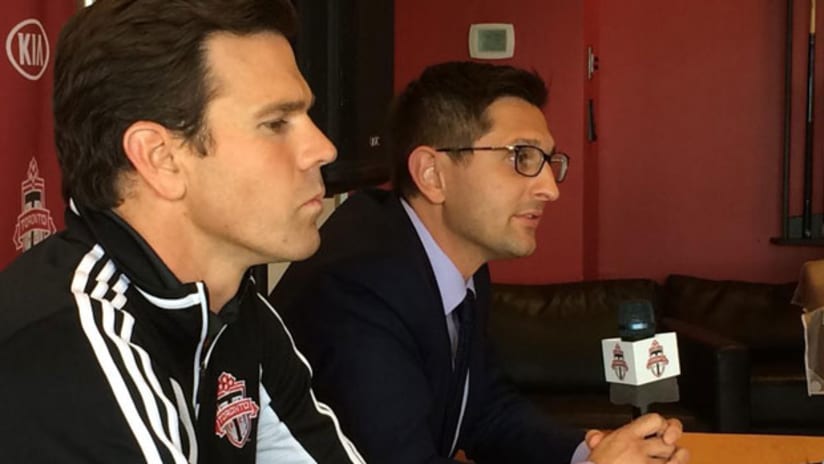TORONTO – Thinking differently.
For Toronto FC head coach Greg Vanney, general manager Tim Bezbatchenko and the rest of the club’s coaching staff, those two words sum up and symbolize the vision being implemented at the club this offseason with a thorough plan in the realm of analytics, sports sciences and cognitive development.
In a meeting with reporters last Thursday, the team brass revealed a number of specialized tools being implemented during the offseason to integrate science into soccer, as the club aims to compete among the very best in the world in that space.
“We spend every day coming in thinking about how we’re going to be different, how we can be better than other clubs in MLS but also better than other clubs internationally,” Bezbatchenko said. “A winning team starts with a club’s vision. When you go into a top club, you feel how things are different. You know you have to meet a different standard when you walk through the doors at Toronto FC.”
Integrating science into sports starts with collecting data from each player, recorded using heart-rate monitors worn during training and interpreted using data-management software. This data helps his staff assess each player’s individual workload in training and chart where they are in terms of weekly preparation, both from a cardiovascular and muscular load standpoint.
“We’ve used heart rate data and what that does is it gives us, for example, in a training session, we know based on some experience that certain exercises cost us a certain number of workload points,” Vanney explained earlier in the season. “We want our players to achieve a certain number of workload points for the week in order to maintain their fitness and not lose their fitness but not be in a position where they are overloading and at risk for injury. So we use the heart rate system to gauge those workload points on each player.”
Vanney has surrounded himself with a staff that covers a wide variety of specialized skills, such as former LA Galaxy, Columbus Crew and Chivas USA conditioning coach Jim Liston and Michael Rabasca, the team’s director of cognitive development, himself a former occupational therapist. Both have integrated their own touch to training, whether it’s specialized, individual training regimen software from a physical side or mind-training exercises to improve cognition from a mental aspect.
These methods aim to optimize each player’s off-the-field or in-practice form into peak on-field performances. Those in-game performances are then captured in video and reviewed by the club’s staff, an area on which Vanney has addressed his focus at the end of the 2014 season.
- The latest TFC headlines from TorontoFC.ca
But, behind the scenes in this realm is analytics consultant Bret Myers. Formerly with the Philadelphia Union, Bezbatchenko hired Myers in 2014 and using a combination of on-field cameras and tracking software, Myers is responsible for scouting opposition as well as analyzing player performances for Toronto.
“We’re capturing every event that happens on the ball and tagging those events and classifying them in a certain way,” Myers told MLSsoccer.com earlier in the season. “So we think about certain phases of the game, attacking, distribution, defending, and we get full insight, not only on our team but the opposition in the whole league.
“Greg likes splitting up the field into little zones,” Myers continued. “The data has X, Y coordinates to it so typically when you look at these reports from the games you get these comprehensive statistics that are broken down into thirds but we can look very specifically into zones that we’re interested in, and maybe we see an opponent has a soft spot somewhere we can exploit.”
Using this tracking software, combined with heart-rate monitors, Myers, Vanney and the rest of Toronto FC’s coaching staff can also work with players to prevent or recover from injuries, too.
“You have that live, real-time monitoring going on and then you can get a report at the end that says at this percentage of time, they’re in their red zone, or close to their maximum heart rate,” Myers explained. “You want to be careful about how much time you spend in those areas.”
“If we get a player, who, for example, we call is ‘running hot,’ then we will pull that player from the training session and modify his session in a way that we don’t push them to a position where we don’t put them at risk for a muscular injury,” Vanney said, adding that the club’s most common injuries – hamstrings, groins and other muscle problems, can be a result of overuse in training.
These methods are being implemented across the board at the club, not only at the first-team level but into the Academy as well. Of course, there are intangibles, but the club brass is hoping these tools will give their side an added edge in 2015.
“These are all tools that we have at our disposal but there’s much more along the way that we’re working towards as we go into next preseason,” Vanney concluded.













